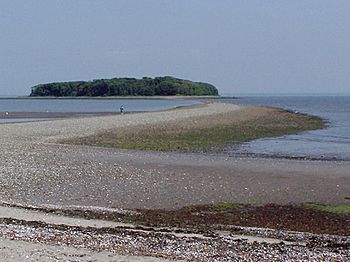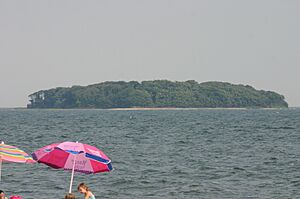Charles Island facts for kids

Charles Island at low tide, including the tombolo
|
|
|
Charles Island (Connecticut)
|
|
| Geography | |
|---|---|
| Location | Long Island Sound |
| Coordinates | 41°11′28.32″N 73°03′18″W / 41.1912000°N 73.05500°W |
| Area | 14 acres (5.7 ha) |
| Administration | |
|
United States
|
|
| State | Connecticut |
| County | New Haven |
| City | Milford |
| Demographics | |
| Population | 0 |
| Pop. density | 0 /sq mi (0 /km2) |
Charles Island is a small island, about 14 acres (57,000 square meters) in size. It is located about 0.5 miles (1 kilometer) off the coast of Milford, Connecticut. The island sits in the Long Island Sound.
You can reach Charles Island from the shore by walking across a natural land bridge. This bridge is called a tombolo (or sometimes a sandbar). It only appears when the tide is low. Long ago, a Native American leader named Sachem Ansantawae reportedly lived on the island during the summer. Europeans first discovered the island in 1614. This happened when Adriaen Block sailed through and mapped the Long Island Sound. The island even shows up on his old map in the Netherlands National Archives.
How to Visit Charles Island
Charles Island is an island when the tide is high. But when the tide is low, you can walk to it! A rocky land bridge, or tombolo, connects the beach to the island.
- Be careful of the tides: Visitors should know that the ocean currents can be strong. The sandbar also gets covered by water twice a day as the tides come in. In 2005, people could cross for at least two hours. However, local people in Milford say the sandbar used to be much wider. Over time, erosion has made the island and sandbar smaller.
- Protecting the birds: To keep the local bird population safe, you cannot walk to Charles Island from May 1 to August 31. Signs are posted about this rule from the Connecticut Department of Energy and Environmental Protection.
- Kayaking safety: If you are kayaking on the side of the island facing away from Connecticut, be aware. The wind and waves can be rougher there. This warning comes from the Milford Fire Department.
The History of Charles Island
Charles Island has had many names and uses over the years.
- Early names: The island was first known as Poquehaug. After English settlers arrived in 1639, it was called Milford Island.
- Charles Deal's ownership: In 1657, a man named Charles Deal bought the island. That's how it got its current name, Charles Island. Deal tried to grow tobacco on the island, which was one of the first times anyone tried this in Connecticut. However, his attempt was not successful.
- Tales of treasure: There's a story that a famous sailor named Captain William Kidd visited Milford in 1699. He was on his way to Boston. Before reaching Boston, he was known to have hidden treasure on another island. People wonder if he might have buried more treasure along the Long Island Sound, perhaps even near Charles Island.
- First homes and resorts: In 1835, the first permanent house was built on the island by John Harris. After he passed away, the island had several different owners. In 1852, Elizur Pritchard bought it. He turned the large house into a summer resort. It was first called Charles Island House, then later Ansantawae House.
- Changing uses: After the Civil War, the resort closed. The island was then used by the George Miles Company for making fish fertilizer. After they left, the island was mostly unused until the 1930s. At that time, a religious group called the Dominican Order opened a retreat there. This retreat, called Aquinas Retreat, had a chapel, small cabins, a dining hall, and religious shrines. The retreat closed in the late 1930s, but you can still see some parts of it on the island today.
Charles Island Today
Today, the State of Connecticut owns Charles Island. It is part of Silver Sands State Park. The island is a special Natural Area Preserve. This means it is protected for the many birds that live and nest there, like herons and egrets.
- Wildlife on the island: White-tailed deer used to be common on the island. In 2011, the Department of Energy and Environmental Protection managed the deer population. This was done to help protect the nesting birds. The waters around the island are home to many fish and sea creatures. You might find bluefish, snapper blues, sand sharks, and horseshoe crabs.
- Oyster farming: Since 2013, an area west of the island has been used for oyster farming. This area is about 3.4 acres (1.4 hectares) in size.



